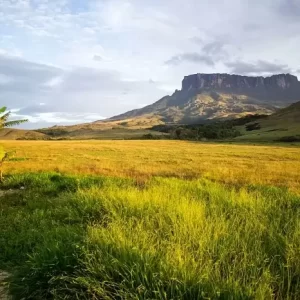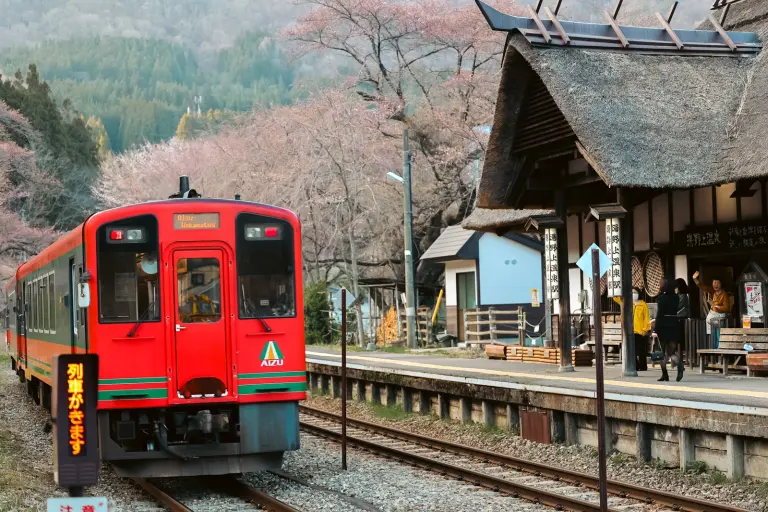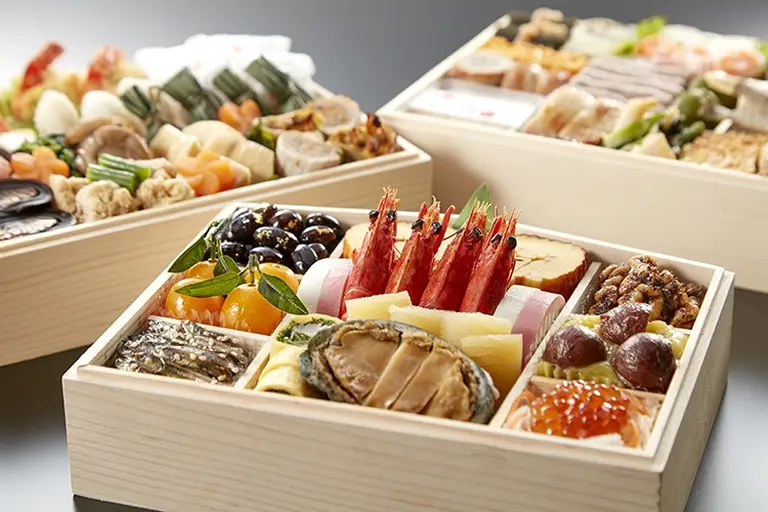Tucked away in Australia’s Northern Territory lies Kakadu National Park, a vast and breathtakingly wild landscape that captivates millions of visitors every year. But Kakadu is more than just a scenic destination—it’s a living museum of ancient culture, biodiversity, and raw natural power.
A Land Older Than Time
Spanning over 19,000 square kilometers, Kakadu is a land of extraordinary ecological diversity. Home to:
- 1,600+ plant species
- 60 kinds of mammals
- 290 species of birds
- 120 reptiles
- 25 types of frogs
- And more than 10,500 insect varieties
This national park is a paradise for nature lovers, researchers, and photographers alike.
But what truly sets Kakadu apart is its rich Aboriginal heritage, with a human history dating back over 40,000 years. As you explore the park, you’re walking on one of the oldest continuously inhabited places on Earth.
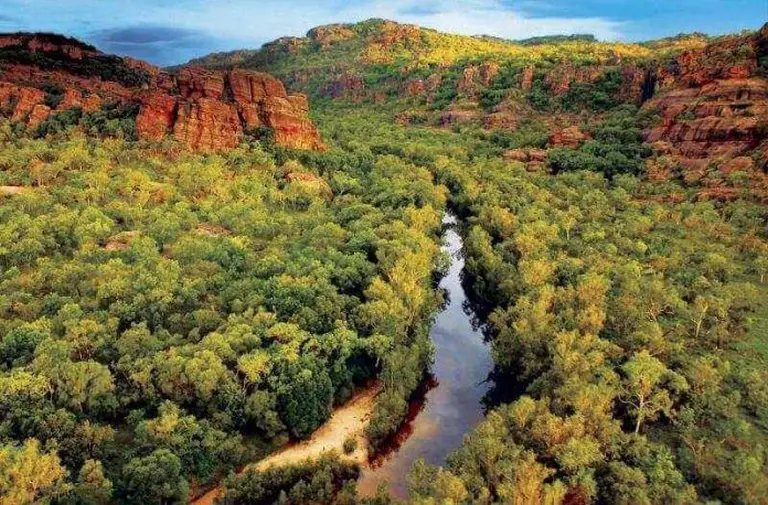
>> Barossa Valley: Where wine dreams come to life
Ancient Rock Art That Tells Stories
One of Kakadu’s most captivating features is its collection of over 5,000 ancient rock paintings, believed to be some of the oldest in the world. These artworks, etched into sandstone cliffs and caves, vividly illustrate daily life, hunting scenes, and spiritual myths from thousands of years ago.
Two of the most famous sites—Ubirr and Nourlangie—offer an unforgettable glimpse into the dreams, battles, and beliefs of Kakadu’s early inhabitants. These sacred rock galleries are not only archaeological treasures but also powerful symbols of Australia’s Aboriginal roots.
Standing before these timeworn illustrations, you’re not just looking at art—you’re stepping into a world that existed long before modern civilization.
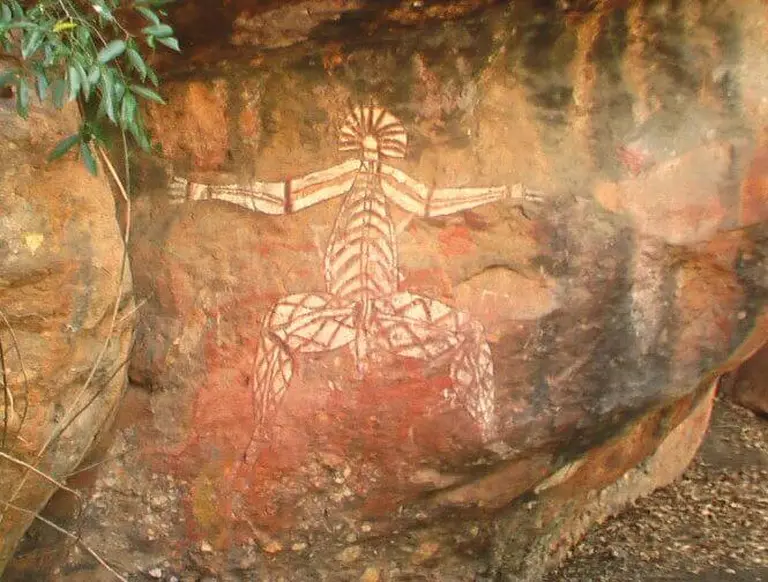
Where Crocodiles Reign Supreme
If there’s one creature that dominates the rivers and billabongs of Kakadu, it’s the saltwater crocodile. These apex predators can be found almost anywhere in the region, from murky swamps to wide-open waterways.
The Yellow Water Wetlands is a prime location for spotting crocs in their natural habitat. For a front-row seat to their behavior, hop on a flat-bottomed boat tour along the Yellow Water Billabong. You’ll witness their stealth, speed, and raw power as they stalk prey and leap from the water in jaw-dropping ambushes.
It’s thrilling. It’s wild. It’s pure Kakadu.
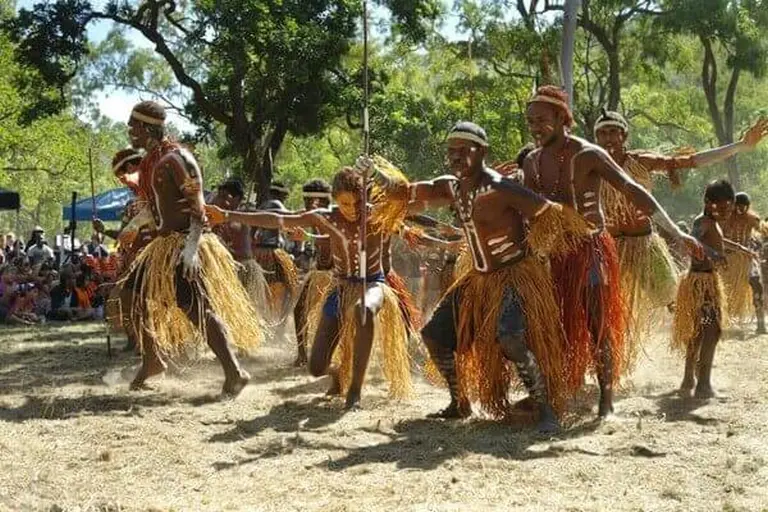
>> Ultimate guide to the Great Barrier Reef: Everything you need to know
A Softer Side of the Wilderness
But Kakadu isn’t all primal and fierce. Hidden among its rugged cliffs and tangled bushland is a scene of unexpected grace: the stunning Jim Jim Falls.
Ranked among Australia’s top 10 waterfalls, Jim Jim is surrounded by towering cliffs and thick greenery. As water plunges from a height of over 250 meters, it creates the image of a giant silver ribbon—elegant, yet powerful—draped across the wilderness.
For adventurous souls, hiking the trail to the top of the falls rewards you with panoramic views of the entire Kakadu landscape. It’s the perfect moment for reflection—and a perfect photo opportunity.
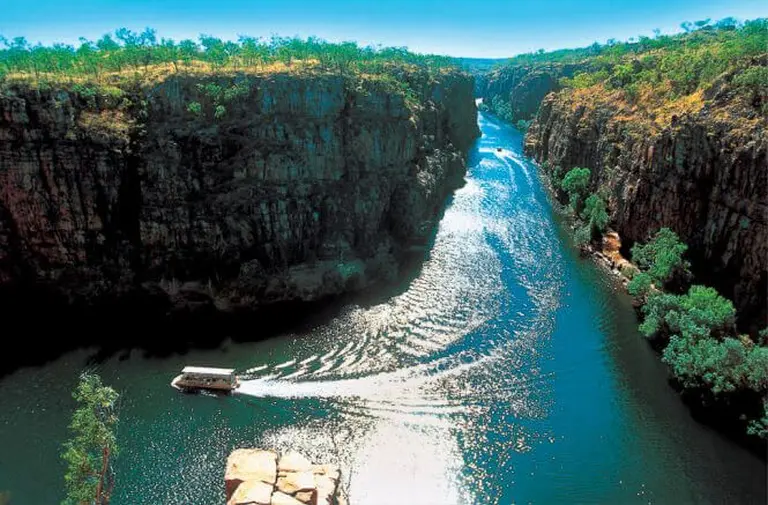
>> Lake Hillier: The mysterious pink salt lake in Australia
Life in Kakadu Today
Despite its wild nature, Kakadu is still home to around 550 Aboriginal people, many of whom continue to live in harmony with the land, following traditional customs and preserving unique cultural practices passed down through generations.
Meeting the locals, learning their stories, and understanding their connection to the land gives your visit an emotional depth you won’t find on ordinary tours.
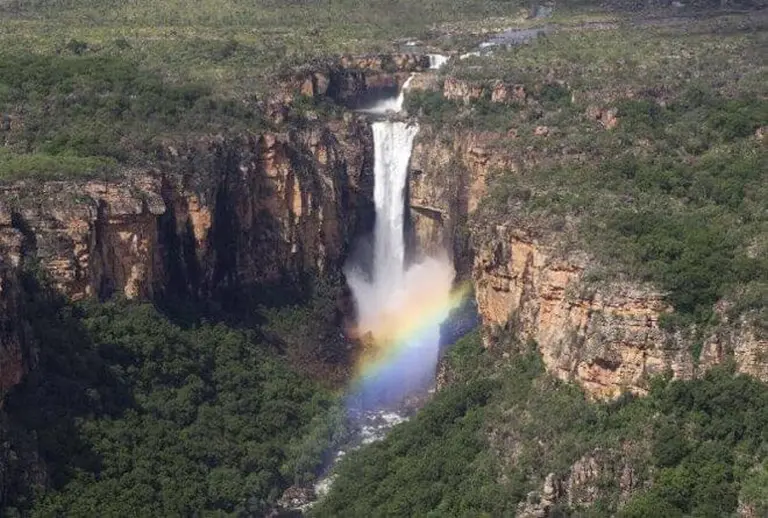
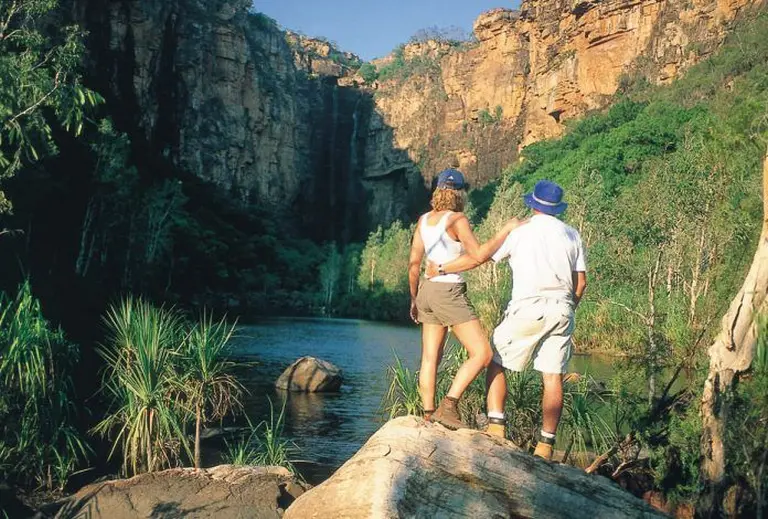
>> Devils Marbles: A stunning natural and spiritual wonder of Australia
Final Thoughts: Why Kakadu is a Must-Visit
Whether you’re chasing crocodile encounters, exploring ancient rock art, or soaking in the serenity of waterfalls, Kakadu is one of Australia’s most powerful natural experiences.
It’s not just a place to visit—it’s a place to feel, to learn, and to remember.
So when planning your Australian adventure, don’t miss Kakadu—where history whispers from the rocks, crocodiles rule the rivers, and waterfalls sing in the silence of the wild.
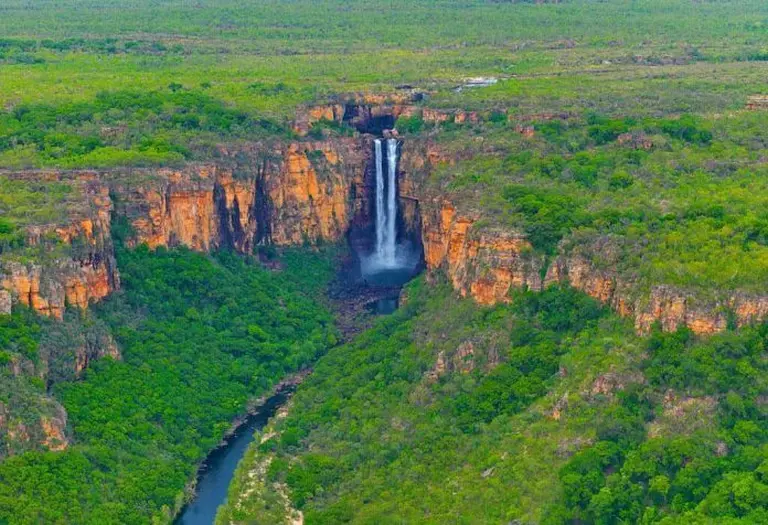
>> Angel Falls: A majestic wonder of Venezuela and the world
FAQ
What is Kakadu National Park?
Kakadu is Australia’s largest national park, located in the Northern Territory, about 170 km (3 hours by car) east of Darwin. Covering nearly 20,000 square kilometers, it’s a UNESCO World Heritage site that blends natural wonders, rich biodiversity, and ancient Aboriginal culture.
Why is Kakadu so special?
Kakadu is often called a living cultural landscape. It’s special for:
- Wetlands teeming with birds and crocodiles
- Towering escarpments and waterfalls
- 65,000+ years of Aboriginal history, rock art, and sacred sites
- Unique wildlife, including saltwater crocs and wallabies
- A mix of monsoon forests, floodplains, and billabongs
It’s both culturally sacred and ecologically extraordinary.
Who are the traditional owners of Kakadu?
The park is jointly managed by Parks Australia and the Bininj/Mungguy people, the traditional custodians of the land. Aboriginal communities have lived here for tens of thousands of years, making Kakadu one of the longest continuously inhabited places on Earth.
What’s the best time to visit Kakadu?
Kakadu has two main seasons, based on Aboriginal understanding:
- Dry season (May–October): Best for hiking, wildlife spotting, waterfalls, and open roads
- Wet season (November–April): Lush greenery, dramatic thunderstorms, fewer crowds – but some areas may be inaccessible
Many travelers prefer the early dry season (June–July) for ideal weather and wildlife viewing.
How do I get to Kakadu?
- Fly into Darwin, the nearest city
- From Darwin, rent a car or 4WD and drive to the park (about 3 hours)
- Guided tours are available from Darwin, ranging from day trips to multi-day adventures
Having your own vehicle offers the most flexibility, especially for remote spots.
What are the must-see attractions in Kakadu?
Top highlights include:
- Ubirr and Nourlangie Rock Art Sites – stunning Aboriginal rock paintings
- Jim Jim Falls & Twin Falls – dramatic seasonal waterfalls
- Yellow Water Billabong Cruise – see crocodiles and waterbirds
- Nawurlandja Lookout – perfect for sunsets
- Maguk and Gunlom Plunge Pools – swim in pristine natural pools
- Mamukala Wetlands – ideal for birdwatching
Can I swim in Kakadu? Are there crocodiles?
Swimming is allowed only in designated safe areas. Kakadu is home to both saltwater and freshwater crocodiles, so always follow local signs and ranger advice.
Popular (safe) swim spots include:
- Gunlom Falls (when open)
- Maguk Gorge
- Motor Car Falls (in the wet season)
What kind of wildlife can I see?
Kakadu is a biodiversity hotspot:
- Over 10,000 crocodiles
- 280+ species of birds (a third of Australia’s total!)
- Snakes, turtles, wallabies, dingoes, and bats
- Unique aquatic life in billabongs and rivers
Birdwatching is especially rewarding during the wet season and at wetlands like Mamukala.
Can I camp or stay overnight in Kakadu?
Yes! There are options for every budget:
- Campsites (some free, some with facilities)
- Eco-lodges and wilderness retreats
- Resorts and hotels in Jabiru (central hub inside the park)
Camping allows you to truly connect with nature and enjoy stargazing in the remote wilderness.
What should I pack for Kakadu?
Essential items include:
- Hat and sunscreen
- Insect repellent
- Plenty of water and reusable bottle
- Sturdy hiking shoes
- Light long-sleeved clothes for sun and bugs
- Camera and binoculars
- Offline maps (some areas have no signal)
Do I need a park pass to enter Kakadu?
Yes, all visitors must purchase a Kakadu park pass.
It’s valid for multiple days and helps support local communities and park maintenance. Passes can be bought online or at park entry points.
Is Kakadu good for families or solo travelers?
Absolutely!
- Families love the educational value, wildlife, and swimming spots
- Solo travelers enjoy the peacefulness, walking trails, and cultural connection
Just be prepared for remote conditions – plan ahead and stay informed via visitor centers and rangers.
How can I learn more about Aboriginal culture in Kakadu?
- Join ranger-led walks and talks
- Visit Bowali Visitor Centre or Warradjan Aboriginal Cultural Centre
- Respect all cultural signs, sacred sites, and local customs
Many tours are led by Aboriginal guides who offer deep insights into the spiritual and ecological meaning of the land.
Kakadu is not just a destination – it’s a raw, untamed journey into the heart of ancient Australia. Whether you’re a nature lover, culture seeker, or adventure traveler, this wild northern treasure offers unforgettable encounters with the land, stories, and spirit of the outback.



